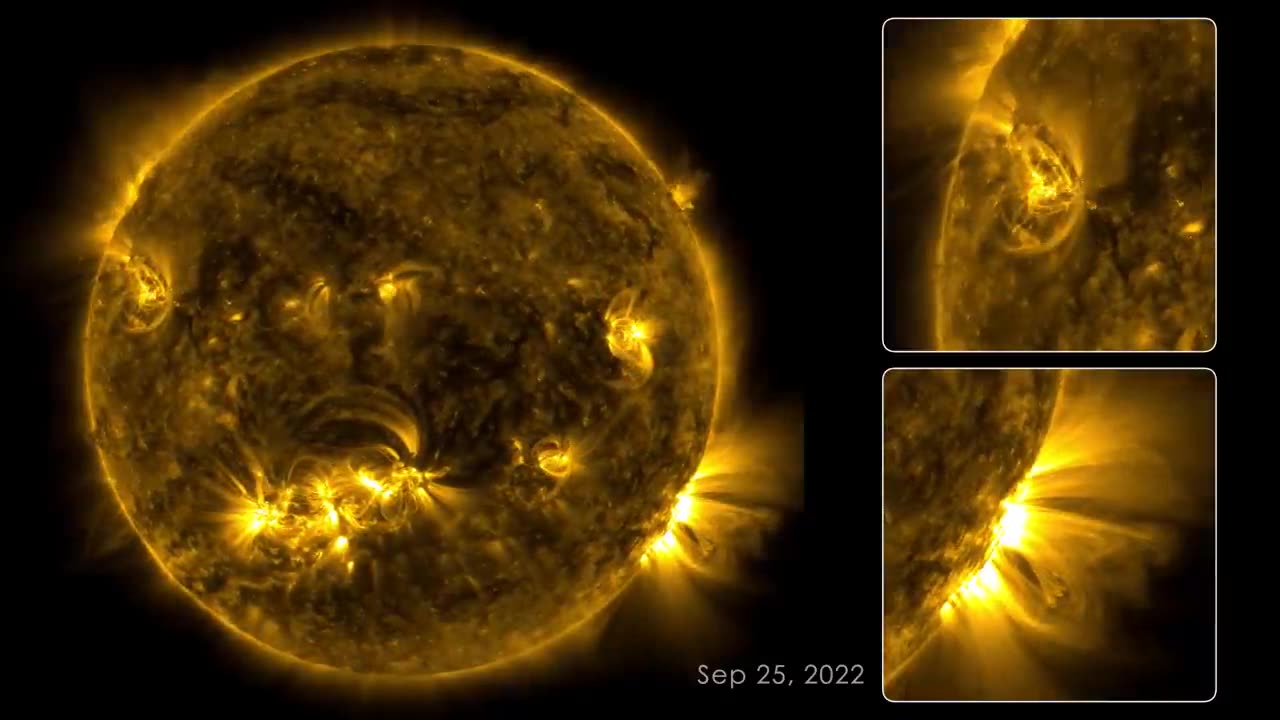Premium Only Content

133 Days on the Sun.TheDailyScop99.
This video chronicles solar activity from Aug. 12 to Dec. 22, 2022, as captured by NASA’s Solar Dynamics Observatory (SDO). From its orbit in space around Earth, SDO has steadily imaged the Sun in 4K x 4K resolution for nearly 13 years. This information has enabled countless new discoveries about the workings of our closest star and how it influences the solar system.
With a triad of instruments, SDO captures an image of the Sun every 0.75 seconds. The Atmospheric Imaging Assembly (AIA) instrument alone captures images every 12 seconds at 10 different wavelengths of light. This 133-day time lapse showcases photos taken at a wavelength of 17.1 nanometers, which is an extreme-ultraviolet wavelength that shows the Sun’s outermost atmospheric layer: the corona. Compiling images taken 108 seconds apart, the movie condenses 133 days, or about four months, of solar observations into 59 minutes. The video shows bright active regions passing across the face of the Sun as it rotates. The Sun rotates approximately once every 27 days. The loops extending above the bright regions are magnetic fields that have trapped hot, glowing plasma. These bright regions are also the source of solar flares, which appear as bright flashes as magnetic fields snap together in a process called magnetic reconnection.
While SDO has kept an unblinking eye pointed toward the Sun, there have been a few moments it missed. Some of the dark frames in the video are caused by Earth or the Moon eclipsing SDO as they pass between the spacecraft and the Sun. Other blackouts are caused by instrumentation being down or data errors. SDO transmits 1.4 terabytes of data to the ground every day. The images where the Sun is off-center were observed when SDO was calibrating its instruments.
SDO and other NASA missions will continue to watch our Sun in the years to come, providing further insights about our place in space and information to keep our astronauts and assets safe.
Video Description:
On the left side of the frame is the full circle of the Sun. It appears in a golden yellow color, but splotchy and with thin yellow wisps extending from the surface. Some areas are very bright and others almost black. The whole Sun rotates steadily, with one full rotation taking 12 minutes in this time lapse. There are usually only a few bright regions visible at a time and they shift and flash like small fires. From these regions there are wispy loops reaching up above the surface that rapidly change shape and size. If you liked this video, follow TheDailyScop99.
-
 LIVE
LIVE
TimcastIRL
1 hour agoTrump FBI Raids John Bolton Amid Classified Docs Investigation | Timcast IRL
17,343 watching -
 LIVE
LIVE
The Mel K Show
3 hours agoMel K w/ Ian Trottier & John Donovan | High Stakes Treason: How John Brennan Compromised American Security for Millions | 8-22-25
601 watching -
 LIVE
LIVE
SpartakusLIVE
3 hours agoWARZONE NUKE IS BACK?! || Solo Challenge CHAMPION to start, duos w/ the Dawg later
2,203 watching -
 LIVE
LIVE
SynthTrax & DJ Cheezus Livestreams
9 hours agoFriday Night Synthwave 80s 90s Electronica and more DJ MIX Livestream OUTSIDERZ Edition
76 watching -
 UPCOMING
UPCOMING
megimu32
1 hour agoOFF THE SUBJECT: FAFO Friday! Shure GIVEAWAY!
43 -
 UPCOMING
UPCOMING
The Amber May Show
46 minutes agoChristian Music Night with Amber May, Wendy Wild & Ace
6 -
 LIVE
LIVE
LFA TV
16 hours agoLFA TV ALL DAY STREAM - FRIDAY 8/22/25
871 watching -
 LIVE
LIVE
Amish Zaku
8 hours agoRumble Spartans August Event- Classic Halo Multiplayer
15 watching -
 LIVE
LIVE
OhHiMark1776
21 hours ago🟢08-22-25 ||||| Halo Multiplayer Rumble: No. 17 ||||| Halo MCC (2019)
98 watching -
 42:57
42:57
MattMorseTV
2 hours ago $0.28 earned🔴Canada just SURRENDERED.🔴
57.4K29